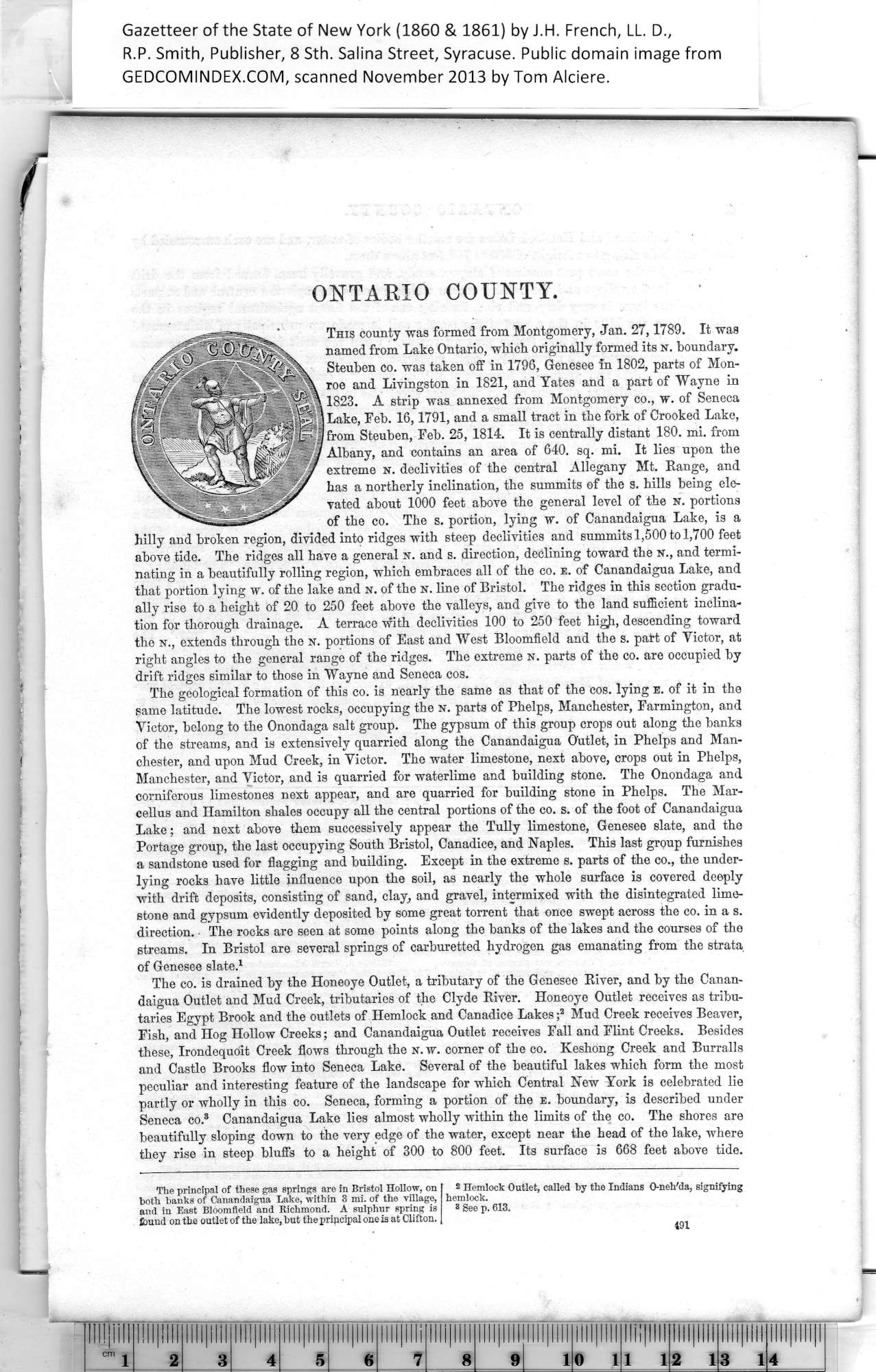|
ONTARIO COUNTY.
This county was formed from Montgomery, Jan. 27,1789. It was
named from Lake Ontario, which originally formed its n. boundary.
Steuben co. was taken off in 1796, Genesee in 1802, parts of Mon¬
roe and Livingston in 1821, and Yates and a part of Wayne in
1823. A strip was annexed from Montgomery co., w. of Seneca
Lake, Feb. 16,1791, and a small tract in the fork of Crooked Lake,
from Steuben, Feb. 25, 1814. It is centrally distant 180. mi. from
Albany, and contains an area of 640. sq. mi. It lies upon the
extreme n. declivities of the central Allegany Mt. Range, and
has a northerly inclination, the summits of the s. hills being ele¬
vated about 1000 feet above the general level of the n. portions
of the co. The s. portion, lying w. of Canandaigua Lake, is a
hilly and broken region, divided into ridges with steep declivities and summits 1,500 to 1,700 feet
above tide. The ridges all have a general it. and s. direction, declining toward the N., and termi¬
nating in a beautifully rolling region, which embraces all of the co. e. of Canandaigua Lake, and
that portion lying w. of the lake and n. of the n. line of Bristol. The ridges in this section gradu¬
ally rise to a height of 20 to 250 feet above the valleys, and give to the land sufficient inclina¬
tion for thorough drainage. A terrace with declivities 100 to 250 feet higji, descending toward
the n., extends through the n. portions of East and West Bloomfield and the s. part of Victor, at
right angles to the general range of the ridges. The extreme n. parts of the co. are occupied by
drift ridges similar to those in Wayne and Seneca cos.
The geological formation of this co. is nearly the same as that of the cos. lying e. of it in the
same latitude. The lowest rocks, occupying the n. parts of Phelps, Manchester, Farmington, and
Victor, belong to the Onondaga salt group. The gypsum of this group crops out along the banks
of the streams, and is extensively quarried along the Canandaigua Outlet, in Phelps and Man¬
chester, and upon Mud Creek, in Victor. The water limestone, next above, crops out in Phelps,
Manchester, and Victor, and is quarried for waterlime and building stone. The Onondaga and
corniferous limestones next appear, and are quarried for building stone in Phelps. The Mar¬
cellus and Hamilton shales occupy all the central portions of the co. s. of the foot of Canandaigua
Lake; and next above them successively appear the Tully limestone, Genesee slate, and the
Portage group, the last occupying South Bristol, Canadice, and Naples. This last group furnishes
a sandstone used for flagging and building. Except in the extreme s. parts of the co., the under¬
lying rocks have little influence upon the soil, as nearly the whole surface is covered deeply
with drift deposits, consisting of sand, clay, and gravel, intermixed with the disintegrated lime¬
stone and gypsum evidently deposited by some great torrent that once swept across the co. in a s.
direction. - The rocks are seen at some points along the banks of the lakes and the courses of the
streams. In Bristol are several springs of carburetted hydrogen gas emanating from the strata
of Genesee slate.1
The co. is drained by the Honeoye Outlet, a tributary of the Genesee River, and by the Canan¬
daigua Outlet and Mud Creek, tributaries of the Clyde River. Honeoye Outlet receives as tribu¬
taries Egypt Brook and the outlets of Hemlock and Canadice Lakes ;2 Mud Creek receives Beaver,
Fish, and Hog Hollow Creeks; and Canandaigua Outlet receives Fall and Flint Creeks. Besides
these, Irondequoit Creek flows through the n.w. corner of the co. Keshong Creek and Burralls
and Castle Brooks flow into Seneca Lake. Several of the beautiful lakes which form the most
peculiar and interesting feature of the landscape for which Central New York is celebrated lie
partly or wholly in this co. Seneca, forming a portion of the e. boundary, is described under
Seneca co.3 Canandaigua Lake lies almost wholly within the limits of the co. The shores are
beautifully sloping down to the very edge of the water, except near the head of the lake, where
they rise in steep bluffs to a height of 300 to 800 feet. Its surface is 668 feet above tide.
2 Hemlock Outlet, called by the Indians O-neh'da, signifying
hemlock.
8 See p. 613.
The principal of these gas springs are in Bristol Hollow, on
both hanks of Canandaigua Lake, within 3 mi. of the village,
and in East Bloomfield and Richmond. A sulphur spring is
found on the outlet of the lake, but the principal one is at Clifton.
491
|
